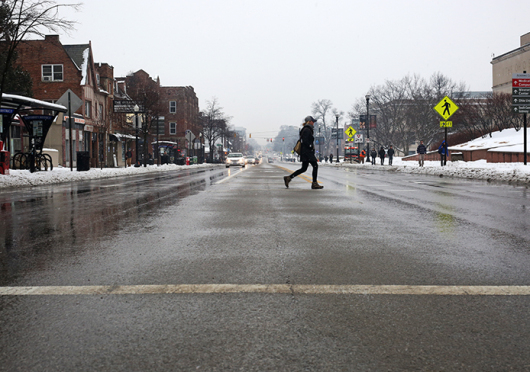
Property owners with land near Ohio State’s campus have submitted a petition to the Columbus City Council, asking for the approval of a special improvement district. Credit: Jon McAllister / Asst. Photo editor
Property owners with land near Ohio State’s campus are pushing for increased security and environmental maintenance in the area.
After receiving a petition from University District High Street property owners, the Columbus City Council is considering approval of a special improvement district, or SID, in the area, which would allow property owners to fund projects specifically targeted at improving the safety and cleanliness of the area.
Ohio law allows property owners in an area to petition for the establishment of a special improvement district in their area “for the purpose of developing and implementing plans for public improvements and public services that benefit the district.” Property owners in the district then pay an additional tax or fee, which is allocated to pay for the services.
Matthew Hansen, executive director of the University Community Business Association, said if the SID was approved, the district would employ additional civilian security forces in the evening and civilian bicycle patrols overnight, who will work with local law enforcement to increase safety in the area.
“We will definitely collaborate with OSU PD, Columbus Police and Community Crime Control,” Hansen said following a public hearing about the district Wednesday at Columbus City Hall.
The public hearing was part of the council’s Small and Minority Business Development Committee meeting, during which Cleve Ricksecker, executive director for the Capital Crossroads and Discovery District SIDs, located in downtown Columbus, described the public safety programs implemented by those districts.
In the downtown special improvement districts, security personnel and law enforcement meet regularly and even share a radio channel, Ricksecker said.
Ricksecker added that about 80 percent of the SID funds, which consist of the money contributed by the property owners in the area, are allocated to the public safety program in the two downtown districts. The district’s security dispatcher is the service used most by residents and business owners.
“We spend most of our time responding to individual requests that come in to our dispatch operation,” he said. “People are pretty smart. They realize that unless there is a 911 emergency, the call is more appropriately placed to the SID.”
Ricksecker said the security officers are able to handle smaller issues that are not of high priority to police, but that would be damaging over time if unenforced.
He said that the Discovery District SID also hired “a full-time outreach professional whose job it is to engage people on the streets and connect them with services and get them off the streets and into housing and other services.”
Wayne Garland, president and owner of Buckeye Real Estate, which owns eight properties in the proposed district, addressed the committee, noting that the University District has a similar need as a result of “vagrants” panhandling along High Street.
“We believe that it is necessary to have more eyes in the community, more activity in the community, and representatives that are there on behalf of the community,” he said, citing the potential increase in traffic because of a recently released university plan to expand and renovate the area.
Campus Partners, a private community planning corporation that works to revitalize OSU’s off-campus neighborhoods, announced last month that it aims to rezone and “transform” 9 acres located around the intersection of 15th Avenue and High Street.
Garland said he has supported the effort to create the SID since work on the project started in the late 1990s because he supports more “uniformity in keeping the trash picked up” and more “boots on the ground” in terms of security.
Until now, the district had been unable to get 75 percent of property owners in the district to sign the SID petition as required by Ohio law.
Hansen told the committee that the proposed district would also employ ambassadors to assist people in the area and to provide environmental maintenance activities such as litter pickup, graffiti removal and snow removal, among others.
He said the allocation of resources in the district would be determined by a board whose members would be elected by property owners in the district. When asked by the committee, Hansen estimated that fewer than 20 percent of properties in the district are residential.
Garland said the development of the SID could help transform the University District.
“We collectively as the University District — what we are trying to do is change it from just a student area to an area that serves all demographics,” he said. “This is just another one of those projects.”
Hansen said he hopes the project will give students “more pride in the university district as a safe and clean place to be, and really adopting it as their own neighborhood, not just for the four years that they are here — or however many years.”
“When they want to return as alumni and visit the area, they can be proud of the area, too, because it is a clean and safe neighborhood to be in,” he said.
If approved by the Columbus City Council, the area would become the fifth special improvement district in the city, said Quinten Harris, deputy director of jobs and economic development for the City of Columbus.
The council will hear two ordinances and two resolutions related to the creation of the proposed district at their next meeting on March 23.


